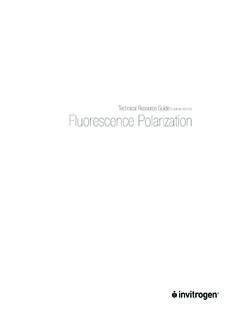Transcription of An Introduction to Algae Measurements Using In Vivo ...
1 1 An Introduction to Algae Measurements Using In vivo fluorescence Submersible fluorescence sensors enable real-time field estimates of phytoplankton that can be directly correlated to standard laboratory quantitative methods. Patrick Sanders Hach Hydromet Phytoplankton are microscopic, free-floating photosynthetic plants and bacteria that are commonly found in surface waters throughout the world. Aquatic scientists and water resource managers measure phytoplankton to gain insights on ecological dynamics, ecological health, nutrient status, and harmful algal bloom potential in aquatic systems. Submersible fluorescence sensors help to make this measurement easy, efficient, and economical by enabling real-time field estimates of phytoplankton biomass that can be directly correlated to standard laboratory quantitative Measurements . Satellite image of a cyanobacteria bloom Introduction to Phytoplankton & Photosynthetic Pigments Phytoplankton come in many different shapes and sizes, including green Algae , cyanobacteria ( blue-green Algae ), diatoms, and dinoflagellates.
2 Most phytoplankton appear green in color due to higher concentrations of green chlorophyll pigments found within their cells. However, phytoplankton can also appear in other colors such as blue-green, red, brown, gold, yellow, and more if they have higher relative concentrations of other pigments within their cells. Other common pigment types found in phytoplankton include phycobiliproteins and carotenoids. 2 Phytoplankton come in many different shapes, sizes, and colors Pigments provide a vital function by absorbing light energy needed for photosynthesis. In this process, light energy from the sun drives a reaction where carbon dioxide and water are converted into sugars. Oxygen is given off as a reaction byproduct. As phytoplankton are able to create their own chemical energy through this process, they are commonly referred to as primary producers within aquatic ecosystems.
3 These primary producers form the foundation of aquatic food webs, where they are consumed by organisms higher up on the food chain, such as zooplankton, invertebrates, and fish. Photosynthesis reaction that occurs within phytoplankton and all photosynthetic organisms The photosynthesis reaction in phytoplankton is powered by light energy absorbed by various accessory pigments and channeled to an energy collecting pigment where a reaction center is located. This energy collecting pigment is typically chlorophyll a, which is present in all phytoplankton. Concentration Measurements of chlorophyll a are frequently used as a standard means of estimating phytoplankton biomass and productivity. In cyanobacteria, the accessory pigments phycocyanin and phycoerythrin are commonly measured to assess cyanobacteria biomass. Importance of Phytoplankton measurement Measuring phytoplankton can provide valuable insights regarding the biological status of any given aquatic system.
4 Some common applications include: Primary Productivity Quantification As phytoplankton form the foundation of aquatic food webs, concentrations of phytoplankton can have a direct effect on all organisms higher up on the food chain. Quantifying primary production through phytoplankton biomass Measurements is a common way to gather direct insights on the baseline energy available within any given aquatic food web. Eutrophication / Nutrient Status Monitoring Eutrophication is the process where nutrients such as nitrogen and phosphorous are loaded into an aquatic system, typically caused by watershed run-off inputs. Eutrophic systems are highly prone to phytoplankton blooms which can lead to dissolved oxygen depletion when phytoplankton cells die off. Phytoplankton monitoring can help water resource managers to control watershed inputs that can affect nutrient loading within aquatic systems.
5 3 Harmful Algal Bloom (HAB) Monitoring Certain species of phytoplankton, mainly cyanobacteria, can release toxins that can cause adverse health effects to humans and animals. Continuous monitoring of phytoplankton levels as part of a broad management plan can help water quality managers to decrease the prevalence of health incidents due to harmful Algae . Drinking Water Management Certain species of phytoplankton can produce compounds that create taste and odor issues in water, including the compounds 2-MIB and geosmin. Proactive phytoplankton monitoring can provide data that helps managers determine when and where to apply algaecide, as well as which source water intakes to pull from in order to minimize the biological load entering a treatment system. An Introduction to fluorescence measurement fluorescence can be described as the phenomena of certain molecules or compounds that absorb specific wavelengths of light and instantaneously emit energy wavelengths of light.
6 Relevant to the topic of phytoplankton measurement , chlorophyll, phycocyanin, and phycoerythrin are all fluorescent pigments that can be measured Using fluorescence instrumentation. fluorescence Measurements of these pigments can be made in vitro ( within the glass ) in the laboratory and in the field with submersible in vivo ( within the living ) fluorescence sensors. Real-time in vivo phytoplankton measurement Using fluorescence sensors on a Hydrolab sonde Within phytoplankton, absorbed light energy in the photosynthetic pigments is channeled to the photosynthesis reaction center, and is either dissipated as heat or re-emitted as fluorescence . On a molecular level, the underlying mechanism of fluorescence is the same for organic or inorganic fluorescent molecules because they both involve the movement of electrons. Specific photons of light energy cause electrons within fluorescent molecules to move to a higher orbital from their original ground state.
7 This electron orbital change lasts a short period, and when the excited electrons return to their ground state, a photon of light at a lower energy wavelength relative to the initial photon is released. This emitted lower energy photon is known as the fluorescence emission. fluorescence sensors measure the fluorescence intensity of an analyte, which is typically directly proportional to its concentration within a linear range. When Measurements are made beyond the linear range, light from the sensor is not able to completely pass into the measurement area due to the density of the analyte (for example, an in vivo chlorophyll a sensor deployed directly within a green Algae bloom). This condition is called quenching and it can cause sensors to read lower than the actual concentration within the measurement area. If spot sampling, one can 4 address quenching by taking grab samples and diluting them by a known factor in order to take Measurements within the linear range of the sensor.
8 Illustration of how the in vivo chlorophyll a fluorescence sensor works on Hydrolab sondes In Vitro Laboratory measurement Methods There are multiple methods of measuring phytoplankton in a laboratory environment. Although these in vitro laboratory methods can be relatively time intensive, carefully collected data from these methods provide highly valuable quantitative data in meaningful mass-to-volume units. The most common laboratory methods used include manual cell counting as well as photosynthetic pigment concentration analysis Using various laboratory procedures and instrumentation. Counting cells in a known volume of water is one laboratory method of quantifying phytoplankton biomass. This method can either be done visually with a microscope or with instrumentation such as a flow cytometer. In the visual counting method, water samples are typically placed in a grid-lined counter cell, which is then placed on a microscope where individual cells can be manually counted by an observer.
9 In the flow cytometry counting method, a flow cytometer instrument is used to count phytoplankton cells that pass through its measurement cell to determine cells per volume concentration. Other common laboratory methods involve various laboratory procedures, reagents, and instrumentation to isolate and measure specific phytoplankton pigments. These methods include in vitro fluorometry, spectrophotometry, and high performance liquid chromatography (HPLC). In these methods, specific photosynthetic pigments are extracted from the phytoplankton cells Using various techniques, and then concentrations of these pigments are determined with instrumentation based upon unique properties of the pigments. Hydrolab In vivo fluorescence Sensors Hydrolab multiparameter sondes utilize directly integrated submersible fluorescence sensors from Turner Designs for in vivo phytoplankton biomass Measurements .
10 Available options include sensors designed to measure in vivo chlorophyll a, phycocyanin, and phycoerythrin pigments. Depending on the objectives of the user, these sensors can be deployed for use in spot sampling, vertical profiling, horizontal profiling, and continuous long-term deployment applications. 5 Hydrolab sondes and sensors. fluorescence sensor shown on bottom left In vivo chlorophyll a is typically the most commonly deployed sensor among the three in vivo phytoplankton fluorescence sensors offered on Hydrolab sondes, followed by phycocyanin and phycoerythrin. The optics on the in vivo chlorophyll a sensor are specifically aligned with the in vivo fluorescence signature of the chlorophyll a pigment. This optical configuration provides in vivo data that is directly relevant to extracted chlorophyll a Measurements , which is important considering that EPA standard methods are specifically based on chlorophyll a pigment concentrations.














